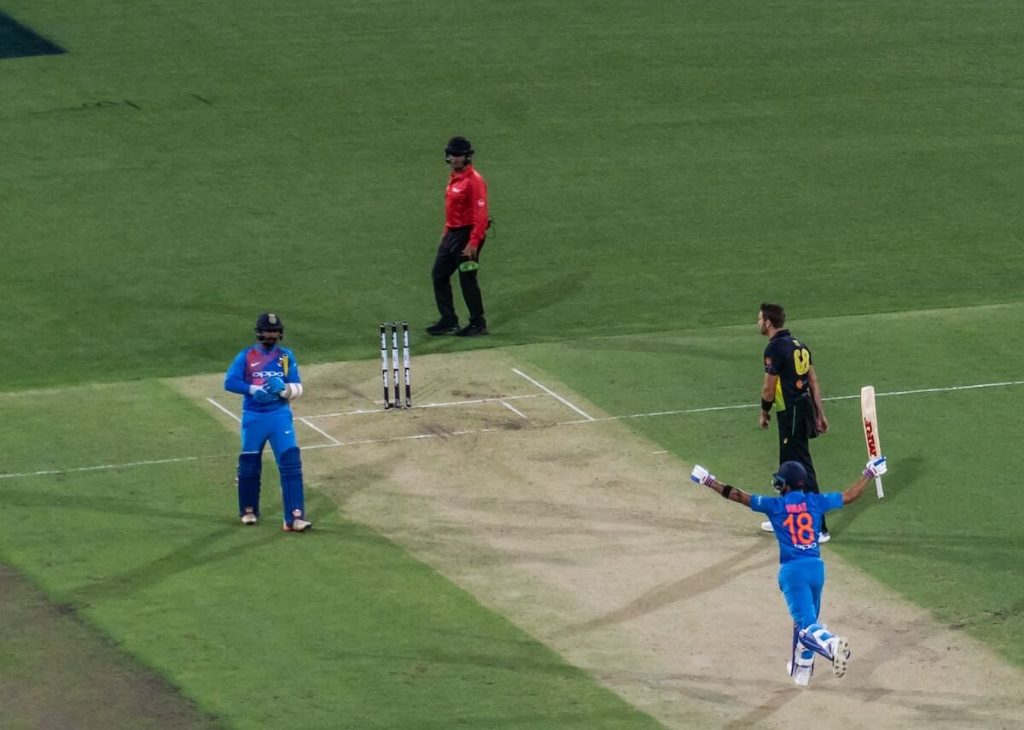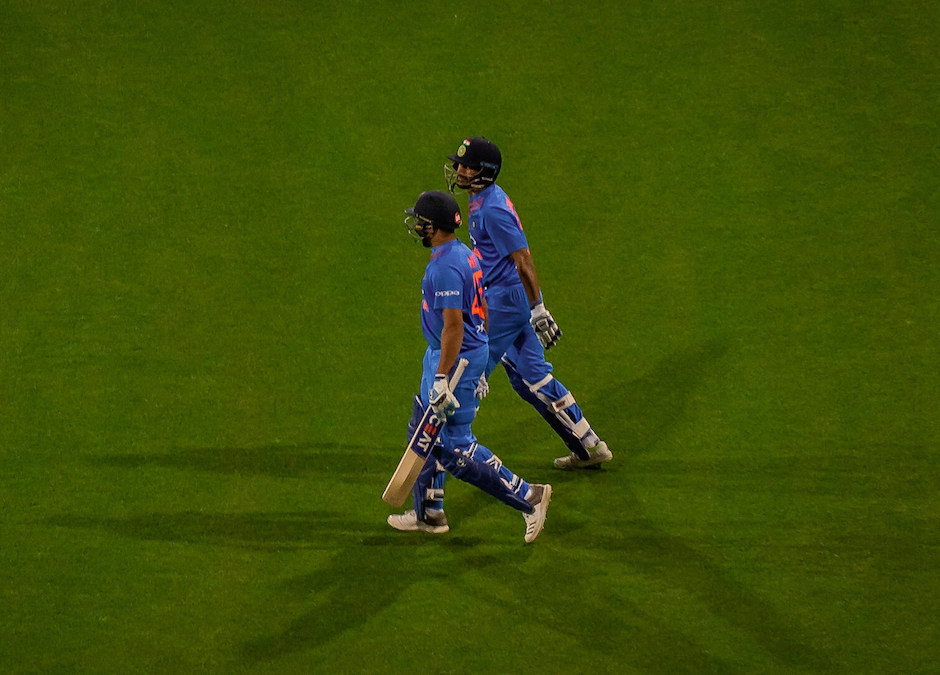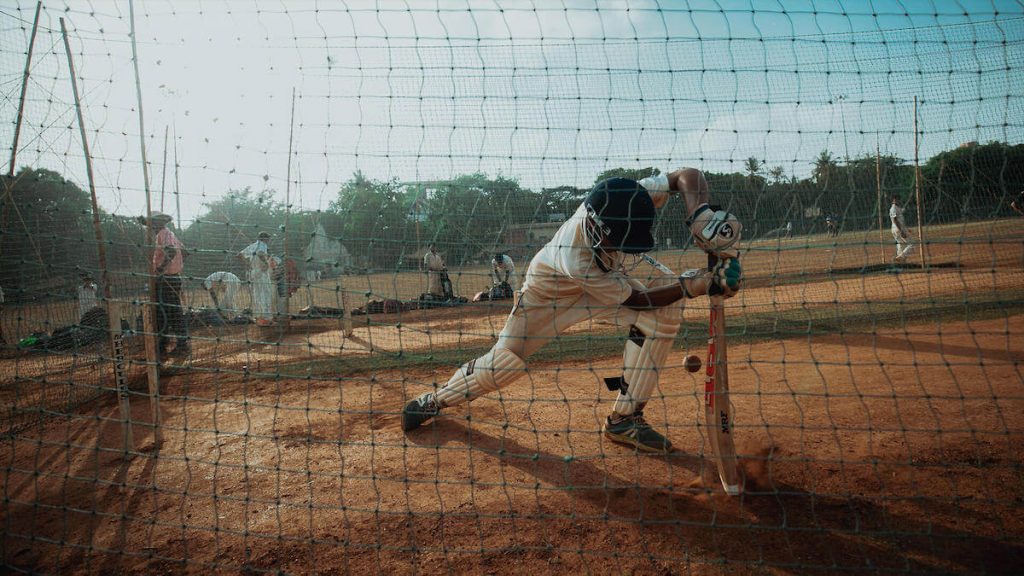The beloved sport of cricket is slightly complex in its nature. But the more knowledge you assume about every aspect of this intriguing game – the more rewarding it will be. In this section, we will explain all the rules and the main expressions used in cricket. We’ll guide you through the most important things you need to know to grasp the allurement of this sport.




Cricket Pitch, Players, and Objects
Cricket is a game between two teams of 11 players each that takes place on a large oval-shaped field. In the center of the field, or the ground is a rectangular area called the pitch. In this area, the two teams take a turn on either bowling or batting.
The batsman will then throw the ball within the pitch. And in both ends of the rectangular area is a wicket placed. A wicket consists of three stumps on which two smaller sticks, called bails, are placed. In front of each wicket, the batting team has a batsman placed to defend the wickets. While a player from the fielding team will throw the ball from one end towards the other.
All players from the fielding team, except the bowler and the wicket-keeper, is spread out on the entire oval-shaped field. The wicket-keeper is placed behind the wicket in the direction which the bowler will aim his throw.
The object for the batting team is to score runs. While the object for the fielding team is to dismiss the batting team from scoring runs.
Cricket Rules FAQ
Cricket is probably the sport with the most rules of all sports in the world. Windia has dissected a handful of the rules as well as the most commonly used expressions.
The fielding team will throw the ball towards the wicket and the batsman will try to hit the ball as far as he can.
The bowler is the player throwing, or bowling, the ball towards the wicket.
Cricket is played between two team and each team has 11 players in the respective team
Basic Cricket Rules
While the fielding team has all eleven players on the field at once. The batting team only has two players who are placed in front of each wicket.
The bowling player from the fielding team will then throw the ball towards the wicket as the batsman will try to hit the ball out on the field. If the batsman succeeds both batsmen will run between the wickets as fast as they can before the fielding team has caught the ball and thrown it back on the wicket or to the wicket-keeper.
The batsmen’s target is to make to the wicket before the fielding team. If they do the batting team will receive points or runs. If the batsman is able to hit the ball outside the field, without hitting the ground inside the field, the batting team will be given six runs.
Cricket coin tossing and how to start the game
From the start, one of the officials will toss a coin and the captain who picks the correct side of the coin will get to choose if they want to bat or field first.
The fielding team’s target is to bowl out all of the batting players, except one (batting is always done in pairs). Because that means the teams will switch sides and the fielding team becomes the batting team and vice-versa. Every time this switch occurs one inning has been covered.
The batsman can be given out by the fielding team in a couple of different ways. These are also called wickets:
- if a batsman starts running towards the other wicket without making it before the fielding team hits the bails
- when the ball is thrown by the bowler and hits the bails behind the striking batsman
- the striking batsmen can hit the ball so that a player from the fielding team is able to catch it before it touches the ground
- when the striking batsman misses the ball and it hits any part of the body of the batsman as the referee judges that the ball was thrown in the direction of the wicket, which is called leg before wicket (lbw).


Important Cricket Expressions
As in every sport, there are a couple of words and expressions that you need to be able to grasp to follow a game of cricket. Some of the more fundamental cricket expressions are explained here.
| Cricket Overs | A game of cricket is divided into overs, where six approved throws by the bowler will make one over. After one over the next takes on throwing towards the other wicket. |
| Cricket Innings | One inning is the period where one of the teams is the batting team. When the fielding team has bowled out all the batting players, except one, one inning has been covered and the teams switch side. |
| Cricket Bowler | The bowler is, obviously, the player from the bowling side who will through the ball towards the wicket. The bowler can either decide to throw the ball fast or to bowl with a spin. The advantage of fast bowling is that it is easier to bowl out the batsman but it is also more chancy since it will give the batsman a lot of power if the ball is hit. Spin bowling is usually safer if you want to decrease the chances of the batsmen to achieve a run. |
| Wicket-keeper | One of the fielding team’s players is placed behind the wicket that is in play and that player is called the wicket-keeper. The wicket-keeper’s task is to catch the ball if the batsman misses. If the batsman starts running the wicket-keeper will then have to hit the bails off the wicket to prevent the batsman from gaining a run. |
| Cricket Batsmen | There are two batsmen on the pitch, while the other players from the batting team are outside the field. As one of the batsmen gets given out a new batsman will replace. It is usually up to the team captain to decide the batting order. |
| Leg Before Wicket (LBW) | It is called Leg Before Wicket if the striking batsman misses the ball and it hits any part of the body of the batsman, as the referee judges that the ball was thrown in the direction of the wicket. |
| Bowled | A batsman can be given out by being bowled. That means the bowler has hit the striking batsman’s wicket and one of the bails is removed by the ball. |
| Caught | The batsman can be caught out if the batsman touches the ball with his bat or hand while holding the bat. |
| Stumped | If the batsman is out of the batsman’s crease and does not attempt to run the batsman can be given out if the wicket-keeper puts down the wicket. If so, the batsman is stumped. |
| Run Out | A batsman can be given out if the batsman if no part of the batsman’s body or bat is grounded behind the popping crease as the ball is in play and the fielding team will put down the wicket. |
| Duck | When a batsman is bowled out without achieving any run, it is called a duck. |
| Golden Duck | When a batsman is bowled out by the first bowl, it is called a golden duck. |
| Royal Duck | When a batsman is bowled out by the first bowl of one inning, it is called a royal duck. |
| Maiden over | A maiden over means that the batting team has not been able to achieve a run in six straight bowls. |
Cricket formats
The game of cricket can be played in a couple of different ways. Where the basic rules are the same but some of the restrictions variates. The most common cricket games are based on the following formats.
Test Cricket
A Test Cricket game has no limitations in terms of the innings length. A game is played up to a maximum of five days. Both teams always wear white clothes and the ball is red. Both teams get to play two innings each. However only if one of the teams has not gained more runs after one inning than the other team has accomplished after two innings. Only the 12 best national teams are qualified to compete in Test Cricket.
Twenty20 Cricket
A game of Twenty20 Cricket, also called T20, is limited to 20 overs per team. This makes the games shorter and they usually last for about three hours. This is the newest and more modern way of playing cricket.
One Day Cricket/One Day International
This is the format that is used when playing the international World Cup of cricket. In One Day Cricket or One Day International both teams get 50 overs if not one of the teams is bowled out. In this format, teams can wear any colors but the ball is white.
First Class Cricket
A game of First Class Cricket applies similar rules as a game of Test Cricket. With the only difference that it is played by domestic club teams instead of national teams.
Knowledge about cricket rules will improve your betting skills
If you have come this far down the cricket rules review you should be a cricket pro by now. The best way to learn more about cricket is to watch cricket. And nothing makes you more involved in the game than when you are betting on it. Check out our cricket betting section to learn more about how to bet on cricket.








